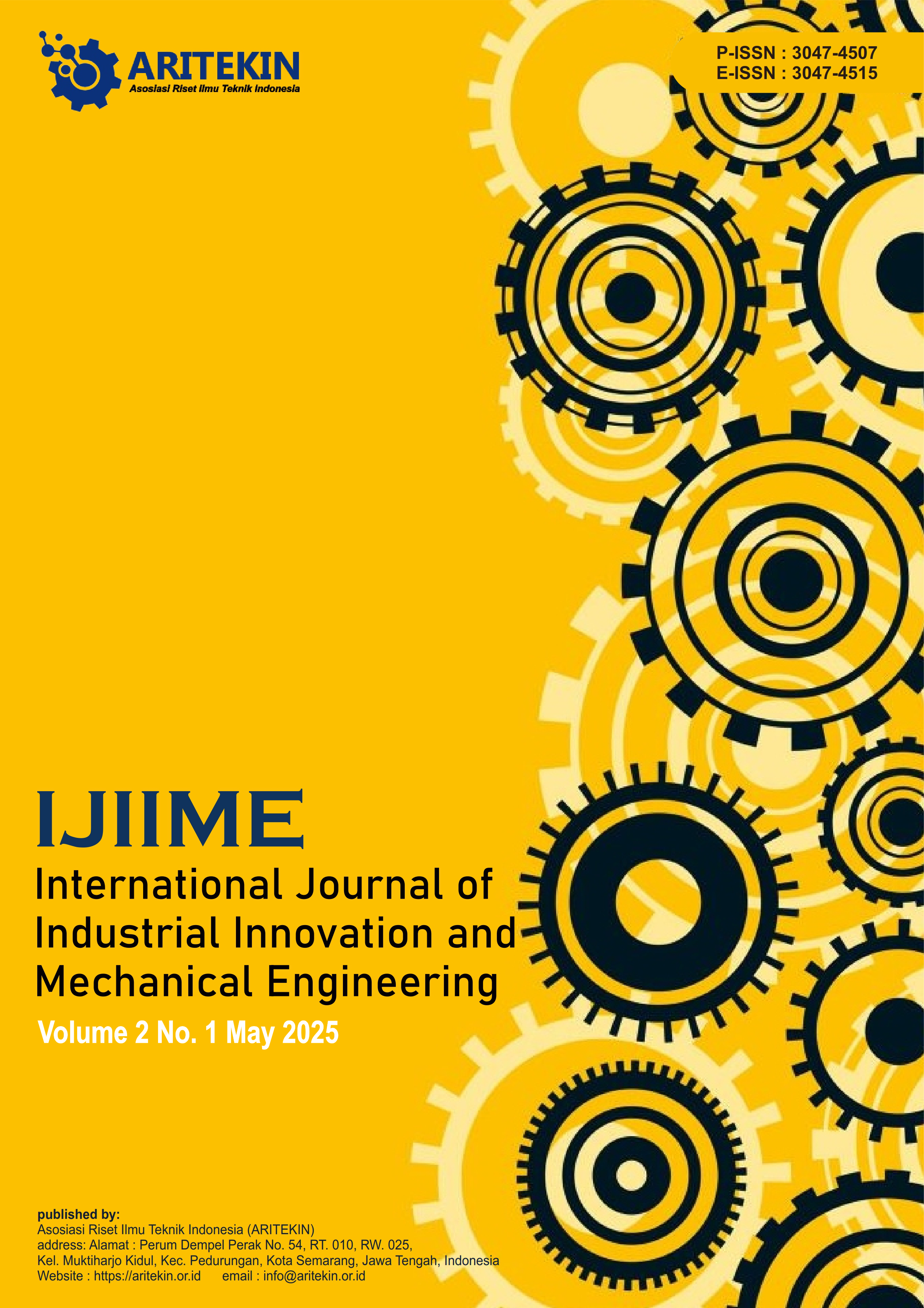Title Impact of Engine Downsizing on Fuel Economy and Carbon Footprint : A Simplified Modeling Approach
DOI:
https://doi.org/10.61132/ijiime.v2i2.269Keywords:
carbon emissions, energy efficiency, Engine downsizing, fuel consumption, LCGCAbstract
Global climate change demands immediate technological advancements, particularly in the transport industry that continues to use fossil fuels. One viable solution is to reduce the size of vehicle engines to make them more fuel-efficient and lower carbon emissions. The purpose of this research is to assess the effect of reducing engine size on fuel consumption and CO₂ emissions in low-cost green car hatchbacks in Indonesia. The technique employed is straightforward analytical modeling, employing Pearson correlation analysis and linear regression among three significant variables: engine capacity, fuel economy, and CO₂ emission. The data are obtained from the technical specifications of four hatchback automobile models, all of which have an engine capacity of less than 1,200 cc. Findings indicate that smaller engine capacity is accompanied by greater fuel economy and lower carbon emissions. The lowest engine size of 998 cc is used in the Toyota Agya, which demonstrates the most efficient fuel and lowest emissions. The statistical analysis shows that there is an inverse relationship between engine size and fuel efficiency, but a positive relationship between engine size and CO₂ emissions. The limitation of sample size causes reduced statistical power of the model. In conclusion, engine downsizing can prove to be a productive approach in promoting green schemes, but additional research with a larger data set and other determinants must be undertaken to establish a more advanced and precise model.
References
Ameya, “Review of vehicle engine efficiency and emissions,” JSTOR, 2018. [Online]. Available: https://www.jstor.org/stable/26649163
Andry and Narelle, “Reviewing in-vehicle systems to improve fuel efficiency and road safety,” Procedia Manufacturing, 2015. [Online]. Available: https://www.sciencedirect.com/science/article/pii/S2351978915008707
Antonio, “Fuel savings on a heavy vehicle via aerodynamic drag reduction,” Transport. Res. Part D, 2010. [Online]. Available: https://www.sciencedirect.com/science/article/pii/S1361920910000301
B. Alain and G. Gaëtan, “Downsizing of gasoline engine: an efficient way to reduce CO2 emissions,” Oil & Gas Sci. Technol. – Rev. IFP, vol. 58, no. 1, 2003. [Online]. Available: https://ogst.ifpenergiesnouvelles.fr/articles/ogst/abs/2003/01/leduc_v58n1
B. Jan, Popis emisního chování vozidel v reálném provozu, Master’s thesis, České vysoké učení technické v Praze, 2021.
D. S. Susanti, Y. Sukmawaty, and N. Salam, Analisis Regresi dan Korelasi. IRDH, 2019.
Darlin, “Kebijakan energi terbarukan: studi kasus Indonesia dan Norwegia dalam pengelolaan sumber energi berkelanjutan,” JIPWP, 2023. [Online]. Available: http://ejournal.ipdn.ac.id/JIPWP/article/view/3684
Dewi, “Potensi panas bumi sebagai energi alternatif pengganti bahan bakar fosil untuk pembangkit tenaga listrik di Indonesia,” Jurnal Ekonomi dan Pembangunan, 2010. [Online]. Available: https://jurnal.dpr.go.id/index.php/ekp/article/view/74
H. Saptoadi, “Rebound effect of LCGC (Low Cost Green Cars): Theoretical approach,” in AIP Conf. Proc., vol. 1755, no. 1, 2016.
International Council on Clean Transportation, European Vehicle Market Statistics Pocketbook 2021/22, 2021.
Kholiq, “Analisis pemanfaatan sumber daya energi alternatif sebagai energi terbarukan untuk mendukung subtitusi BBM,” Jurnal IPTEK, vol. 19, no. 1, 2015. [Online]. Available: https://ejournal.itats.ac.id/iptek/article/view/12
M. Balaji et al., “Scope for improving the efficiency and environmental impact of internal combustion engines using engine downsizing approach: A comprehensive case study,” in IOP Conf. Ser.: Mater. Sci. Eng., vol. 1116, no. 1, p. 012070, 2021.
M. Ehsani, A. Ahmadi, and D. Fadai, “Modeling of vehicle fuel consumption and carbon dioxide emission in road transport,” Renew. Sustain. Energy Rev., vol. 53, pp. 1638–1648, 2016.
M. M. Yusoff, N. M. Zulkifli, B. M. Masum, and H. H. Masjuki, “Feasibility of bioethanol and biobutanol as transportation fuel in spark-ignition engine: a review,” RSC Adv., vol. 5, no. 121, pp. 100184–100211, 2015.
Michelle, Xingbao, Xueyi, Marek, Nima, and Yexin, “Engine emissions with air pollutants and greenhouse gases and their control technologies,” J. Cleaner Prod., 2022. [Online]. Available: https://www.sciencedirect.com/science/article/pii/S095965262203832X
N. A. Abdel-Halim, “Use of Vehicle Power-train simulation with AMT for fuel economy and performance,” Mod. Mech. Eng., vol. 3, no. 3, pp. 127–135, 2013.
N. Humaida, Dasar-Dasar Pengetahuan Lingkungan Berbasis Perubahan Iklim Global. UrbanGreen Central Media, 2024.
P. Schober, C. Boer, and L. A. Schwarte, “Correlation coefficients: appropriate use and interpretation,” Anesth. Analg., vol. 126, no. 5, pp. 1763–1768, 2018.
René and Henri, “The environmental load of household consumption using some methods based on input–output energy analysis,” Energy Policy, vol. 34, no. 17, pp. 2840–2857, 2006. [Online]. Available: https://www.sciencedirect.com/science/article/pii/S0301421505001138
Richard and Philip, “Internal combustion engine cold-start efficiency: A review of the problem, causes and potential solutions,” Energy, vol. 80, pp. 663–673, 2014. [Online]. Available: https://www.sciencedirect.com/science/article/pii/S0196890414001939
S. A. F. Al-Arkawazi, “Studying the relation between the engine size and manufacturing year of gasoline-fueled vehicles and exhaust emission percentages and concentrations,” J. Mater. Environ. Sci., vol. 11, no. 2, pp. 196–219, 2020.
S. B. H. Purba and Y. E. Nizmi, Pengaruh kebijakan low cost green car terhadap strategi Nissan Motor Corporation menguasai pasar otomotif di Indonesia, Doctoral dissertation, Riau University, 2015.
Sudarti, “Analisis perubahan iklim dan global warming yang terjadi sebagai fase kritis,” Jurnal Pendidikan Islam, vol. 8, no. 1, 2022. [Online]. Available: https://jurnal.ar-raniry.ac.id/index.php/jurnalphi/article/view/13359
T. Johnson and A. Joshi, “Review of vehicle engine efficiency and emissions,” SAE Int. J. Engines, vol. 11, no. 6, pp. 1307–1330, 2018.
Downloads
Published
How to Cite
Issue
Section
License
Copyright (c) 2025 International Journal of Industrial Innovation and Mechanical Engineering

This work is licensed under a Creative Commons Attribution-ShareAlike 4.0 International License.





